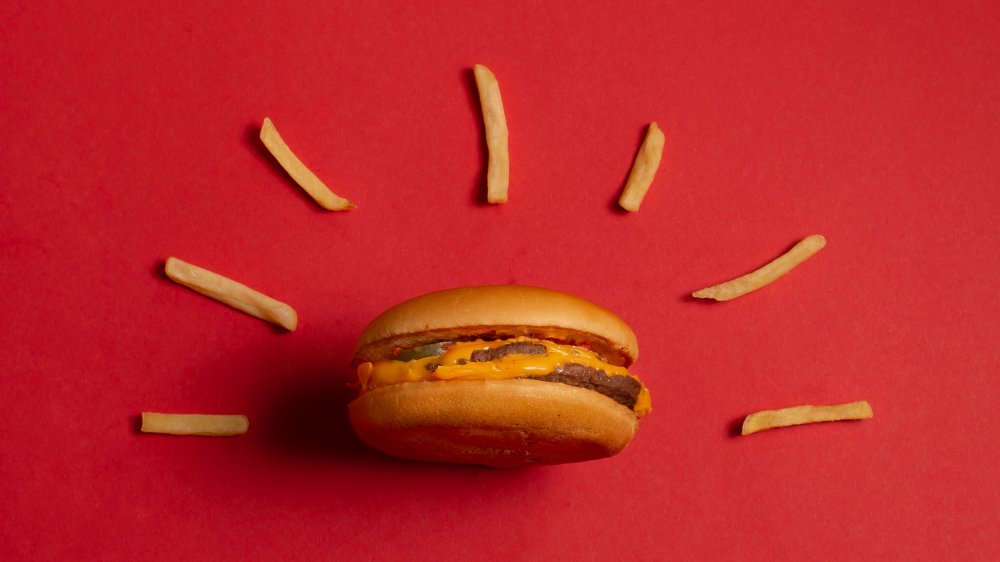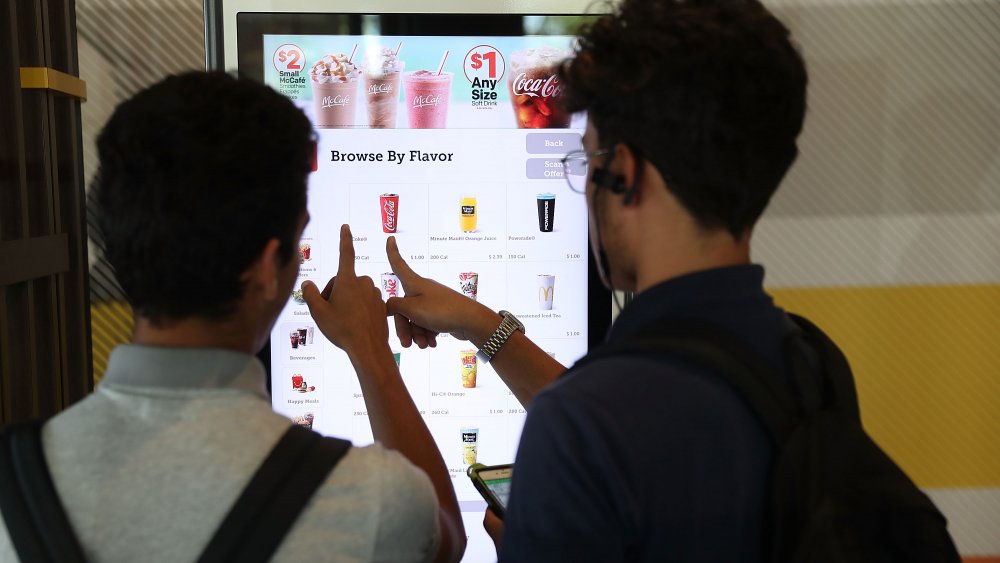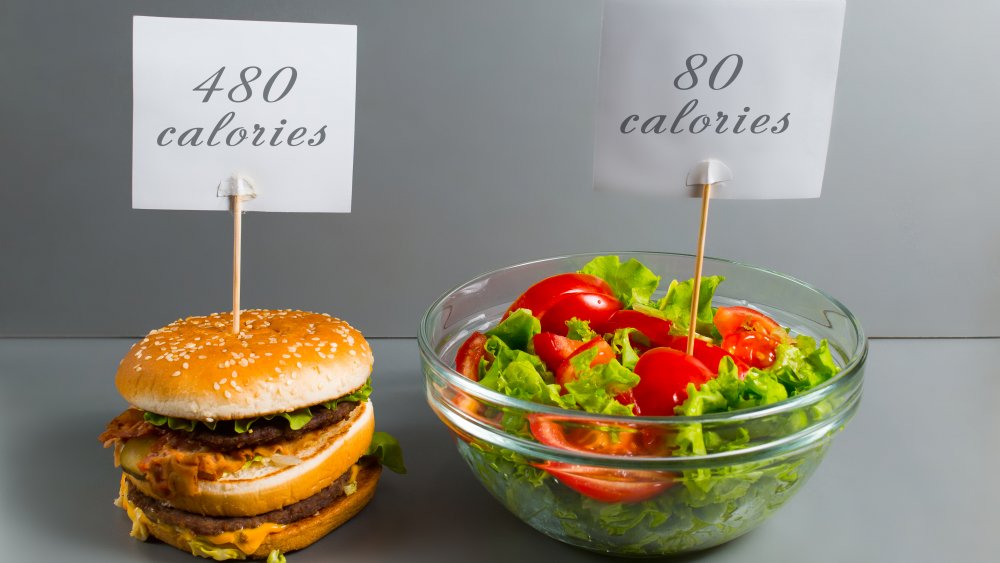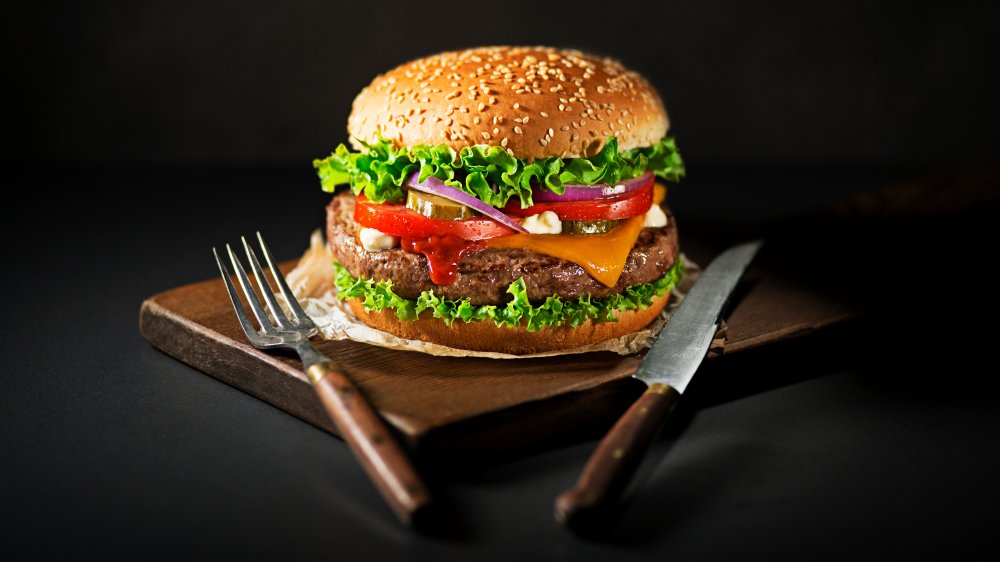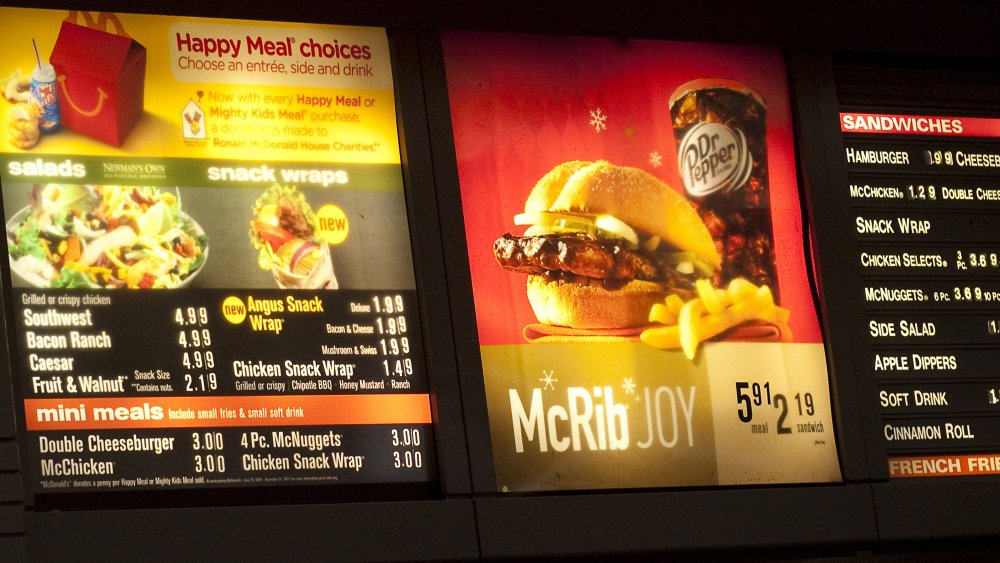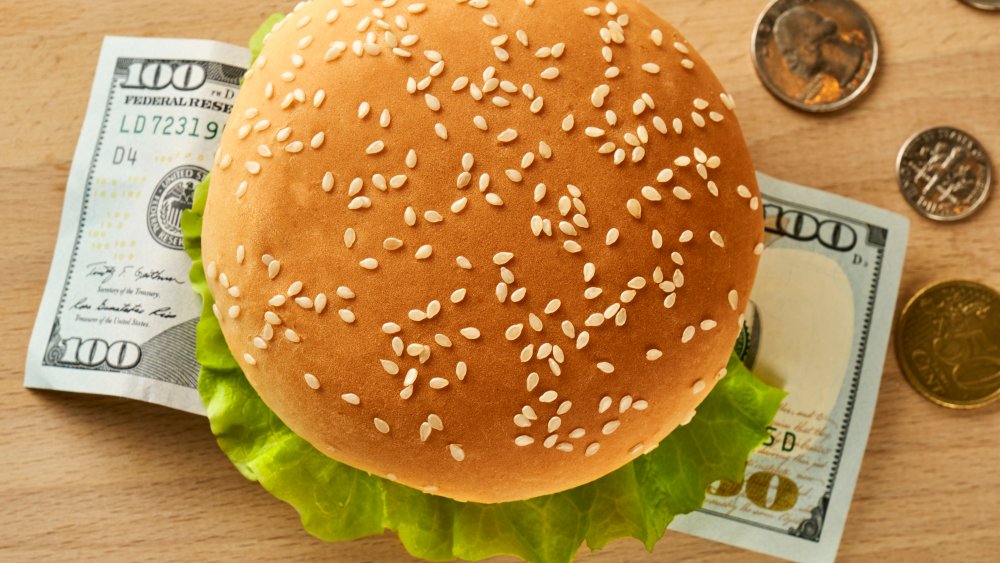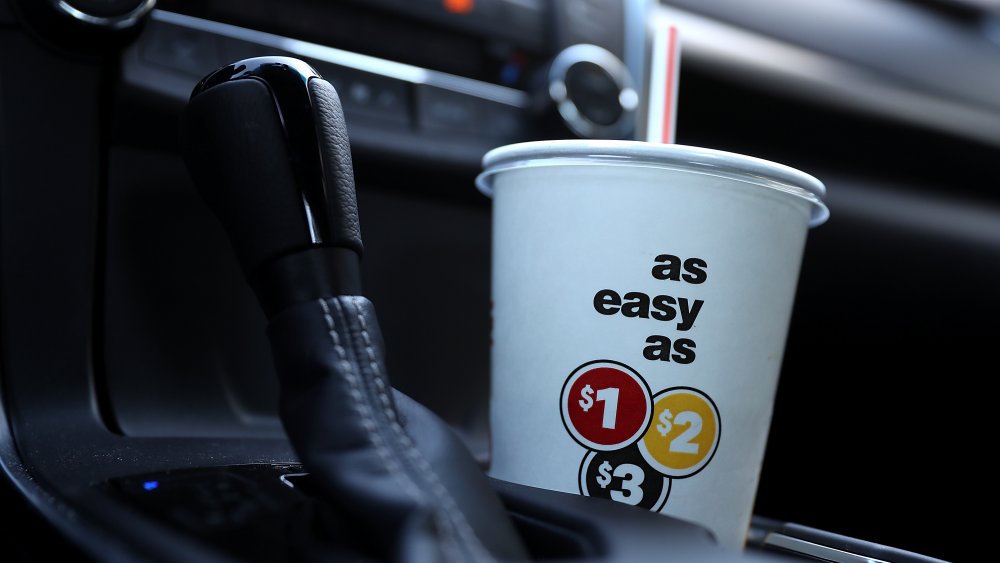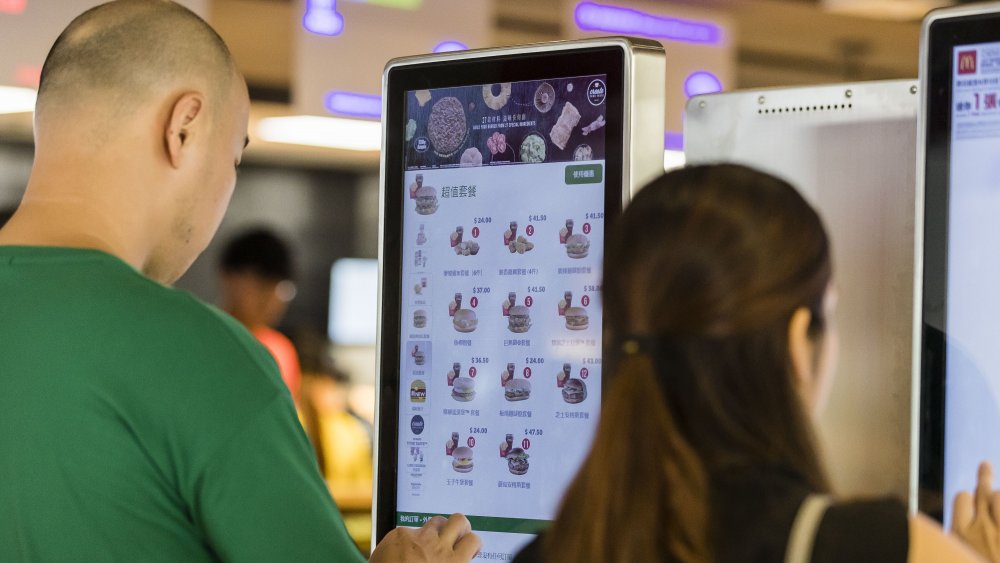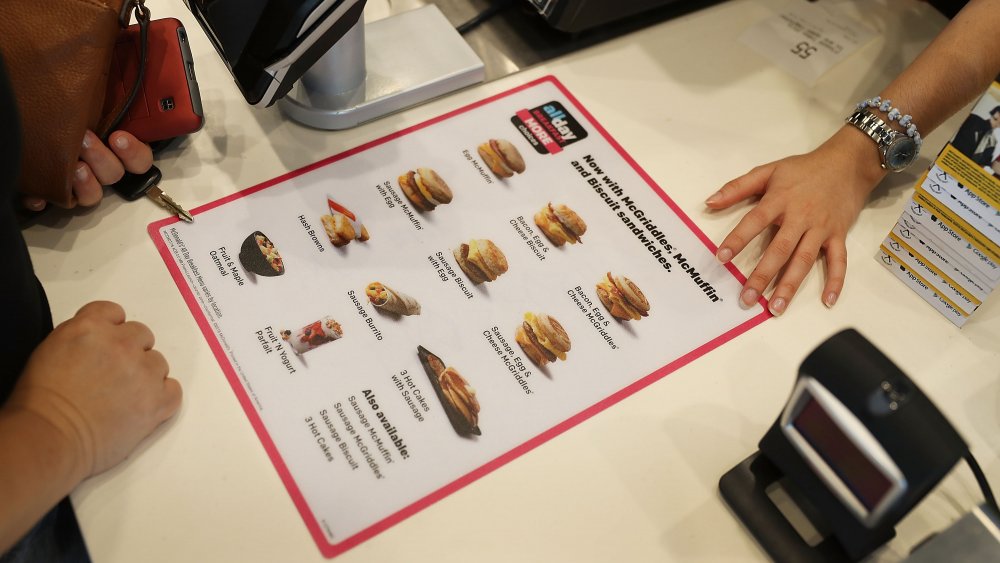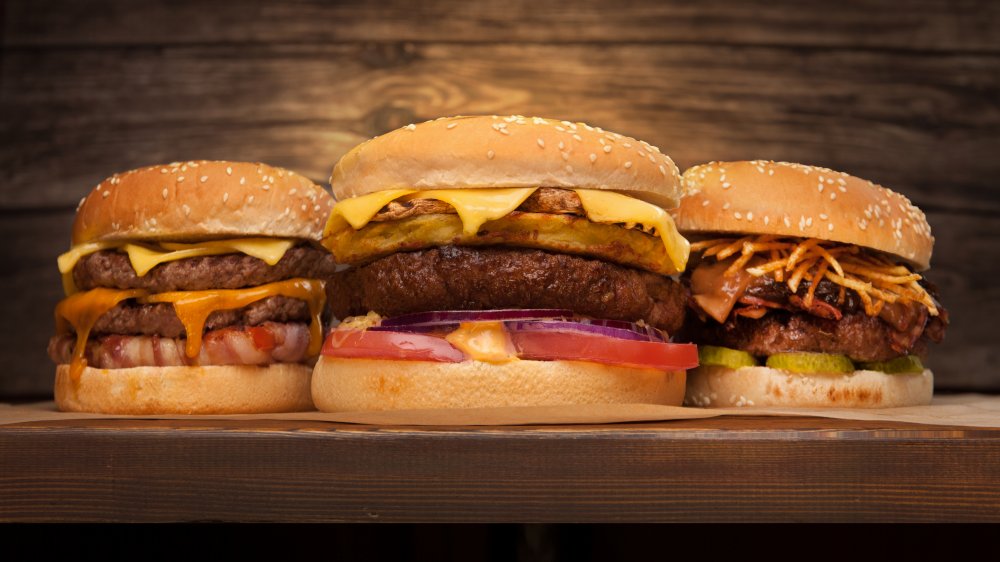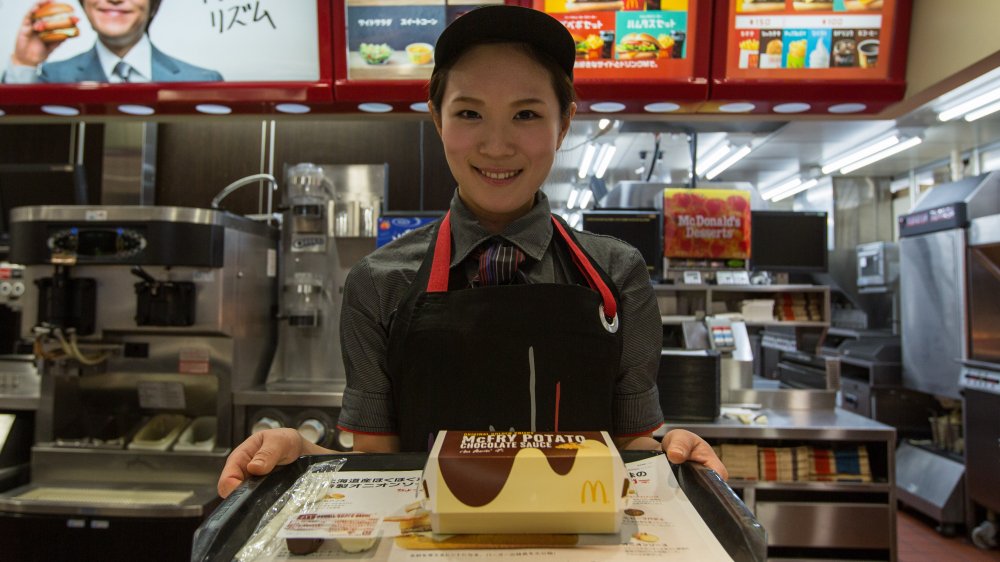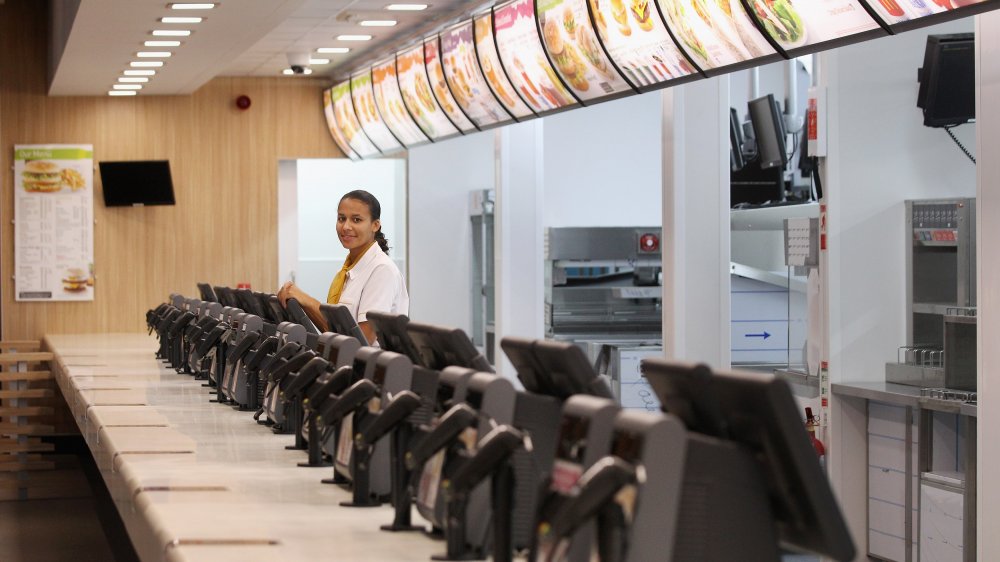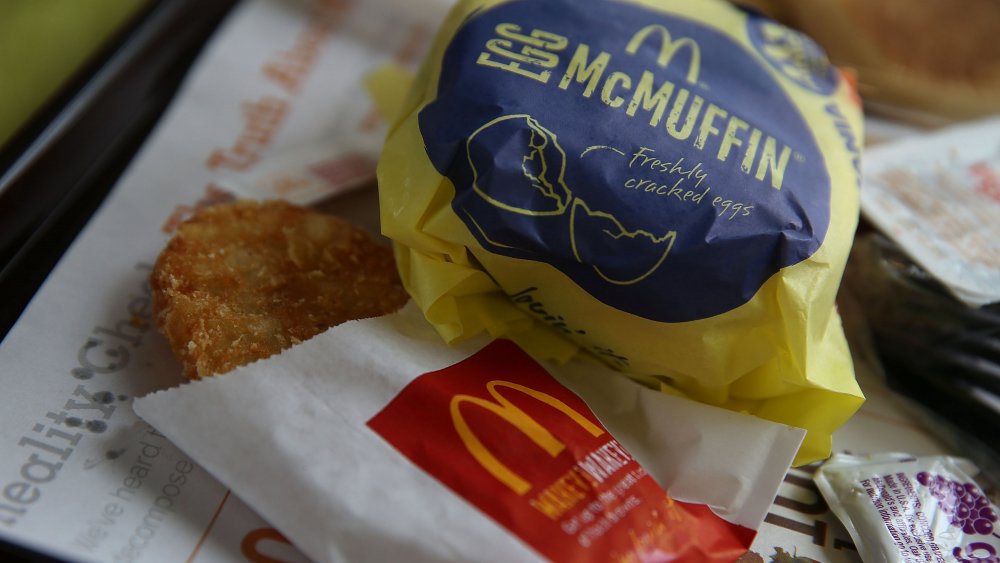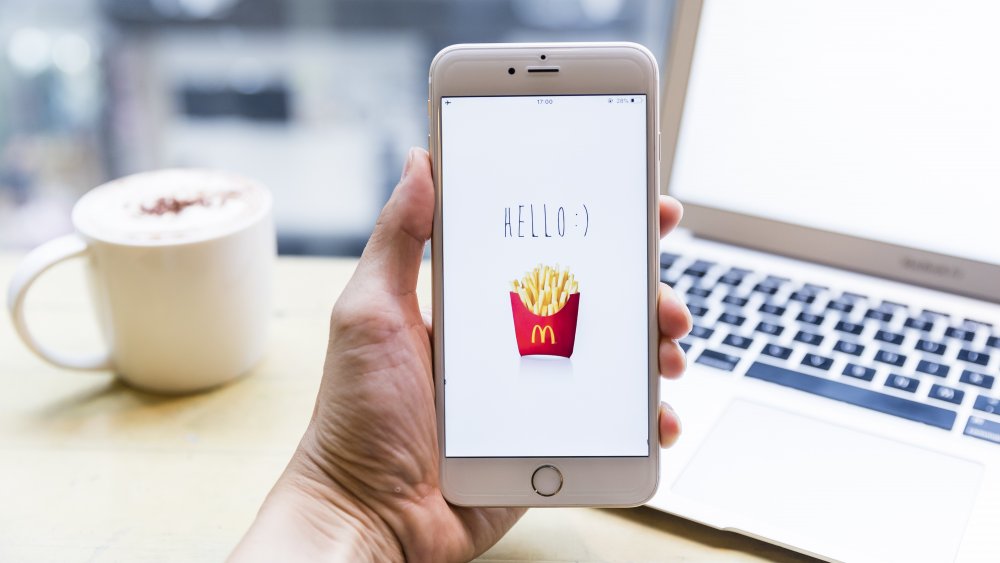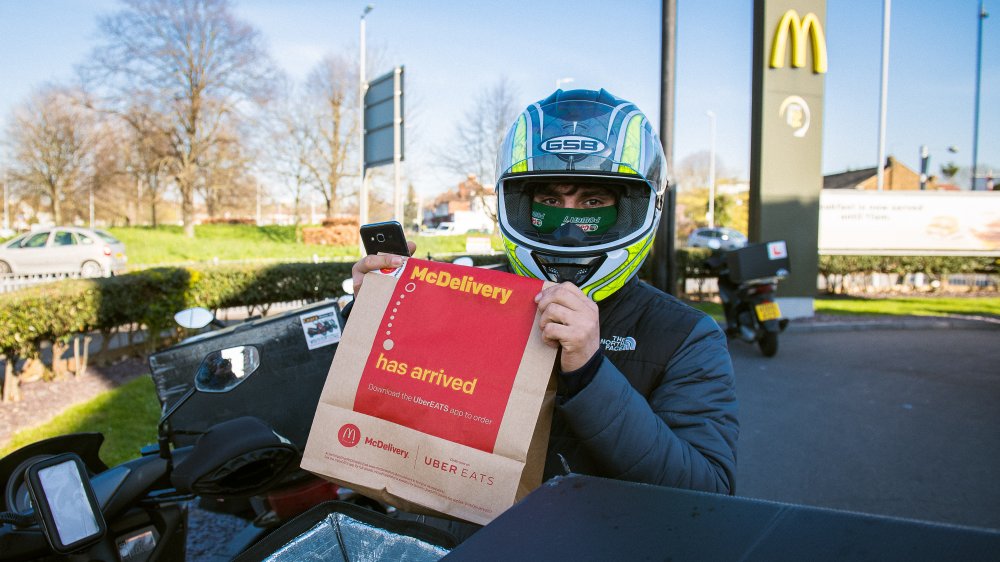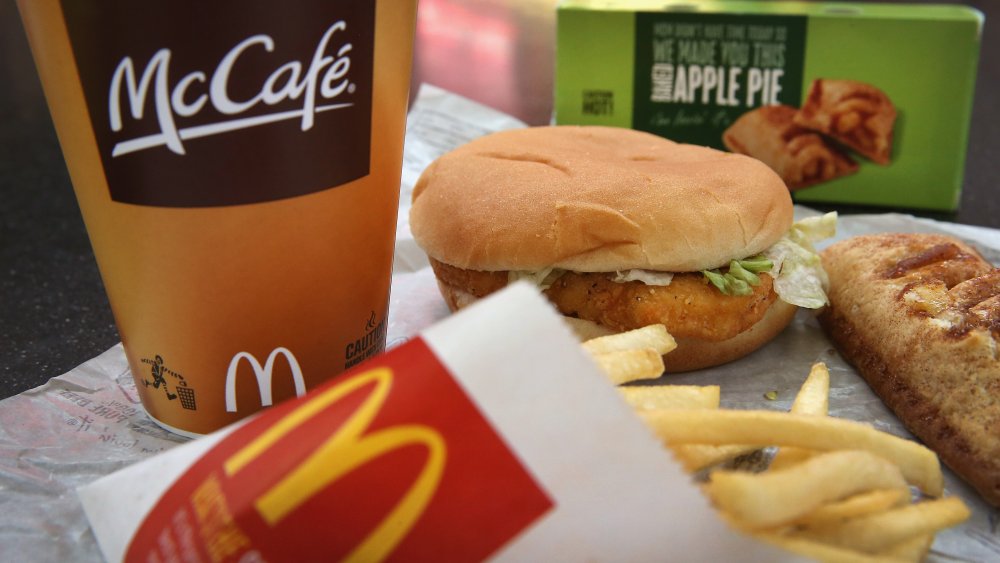The McDonald's Tricks That You Fall For Every Time
Since the 1940s, McDonald's has had a grasp on our collective psyche in a way every other fast food company can only dream about. Whether you like it or not (and regardless of whether it's right or wrong), there's no denying that when it comes to marketing, advertising, and overall food culture, McDonald's has immense power and influence around the world.
What is it about this ubiquitous chain and those distinctive yellow arches that has such a hold on one of our most basic, most emotional human needs? What are the tricks and tactics that McDonald's employs to keep its control on our stomachs, memories, and pocketbooks? Though the ratios of salt, sugar, and fat don't hurt, there's more to it than just the taste of McNuggets and Big Macs that keep us coming back for more. And more. And more. Here are the McDonald's tricks you fall for every time.
McDonald's subtle animation trick
Human eyes are attracted to movement, and McDonald's puts this to good use in their marketing with "subtle animation." By using small movements, they are able to direct customers' attention away from cheaper, familiar items and towards more expensive, newer items, according to Market Watch. This helps to combat something known as "status quo bias" where customers only want to get their old favorites, like the classic Double Cheeseburger or Filet-O-Fish.
These types of animations are so small you could easily miss them. Sometimes it's just a brief highlighting of a word or the spinning of a new menu item's title. You'll see these animations not only on the kiosks, but also on the digital displays and menus at the checkout. The reason it works is because our eyes are meant to track changes in color, speed, or shape. According to Behavioral Economics, this is to help us spot danger in the wild — or, you know, the products McDonald's wants us to buy.
Additionally, by forcibly moving our eyes around the digital displays, McDonald's is also injecting a wider variety of menu options into our short-term memory. With more options to choose from, it's more likely customers will divert from their usual order for something different and pricier.
McDonald's health halo trick
Let's face it: Not many people go to McDonald's to have a healthy meal. We all know that part of what makes McDonald's so delicious is its highly processed, super salty food-like consumables. But as consumers become more knowledgeable about food sourcing and nutrition, McDonald's has had to battle consumer's personal guilt that comes from eating fast food, while also tricking us into a habit of cognitive dissonance in our food choices.
For some reason, research has shown that simply including healthy options on a menu can encourage consumers to actually purchase more unhealthy items, Behavioral Economics reported. Even an image of a simple salad or a bottle of water behind a McDonald's burger can give the overall impression of a "healthier" restaurant, alleviating guilt, and causing a trend towards indulgence. According to Delish, it's all just an illusion. The food is not actually healthier and many of the meals don't come with salad or water — but it works.
Human beings are complicated. As reported by Market Watch, while our brains might say "this is unhealthy and bad for me," our actions directly contradict our thoughts. Instead of ordering the salad featured on the screen, you order the Double Quarter Pounder with Cheese. With a large fry. And a milkshake. And McDonald's knows you'll do this.
McDonald's image placement trick
While you may think of McDonald's as a restaurant with a few different sections — there's the dining area, ordering kiosks, checkout, drive-thru, etc. — marketing experts go even further. They see every wall, nook, and cranny as advertising real estate. When it comes to using images to their advantage, McDonald's is all about location, location, location.
The most obvious way McDonald's uses strategic placing of beautiful images is through something called "decision anchoring." Research shows that when confronted with choices, humans are most likely to pick the first item presented to them. Even at a buffet, people will tend to fill their plate with the first three items they see, according to Behavioral Economics.
McDonald's makes good use of this psychology by placing photos of the items they want you to buy right at the entrance. Before you even make it to the menu, they're trying to influence you to buy something pricier than what you'd normally get. For a long time, it was their Signature Crafted Recipes, but really it's whatever corporate is trying to push at the given time, Market Watch explained.
McDonald's menu board trick
The curated menu board is an example of several different McDonald's advertising practices combined, but on a smaller scale. The menu board is not simply an innocent list of all the McDonald's items you'd expect, but rather a last-ditch effort by the company to influence your decision-making.
Like on the kiosks, the menu boards will use subtle animation to draw the customer's eyes across the board and onto specific items, thus influencing the buyer to subconsciously consider more items. And, much like the placement of certain photos at specific locations within the restaurant, McDonald's also dedicates certain percentages of its menu board to certain types of items, according to Delish.
While a hamburger may not even take up a line on the menu, a new or expensive item may take up a quarter or more of the board — and include a picture. The majority of the "menu" is therefore not the actual menu, but advertising space. This leveraging of menu real estate is why it's hard to find old classics and easier to find "deals" or new items that make you spend more overall. It all comes down to breaking customers out of their value-menu habits.
McDonald's no prices trick
While McDonald's might be quick to highlight the price of certain deals, you're unlikely to see the actual cost of most items on its promotional material. This is all a purposeful attempt to lessen the psychological pain of eating out and spending money. According to Behavioral Economics, consumers tend to care more about the money lost than the goods they get in exchange. So even if you purchase something you really wanted, your mind will still be more focused on the money you had to pay for it. Humans, right?
McDonald's advertising makes sure we only think of the joy of purchasing food, not the pain of spending money. That's why there is almost no mention of price on any of the photos. Any mention of spending money, however, is put in the context of how much money you're saving in exchange for the delicious goods you'll receive. It's no accident that McDonald's most well-known set of items is the Dollar Menu (now called the $1 $2 $3 Menu), which they've brought back again and again.
McDonald's cheap (and expensive) tricks
McDonald's knows how to use competition to its advantage and the Dollar Menu plays a role in this competition, both internally and externally. McDonald's uses price anchoring to create emotional responses to different menu items. By pitting, say, the Dollar Menu or cheaper, classic menu items against newer lines, collections, or limited edition items, McDonald's is able to manipulate our behavior.
For example, just a couple years ago, McDonald's scaled back its Dollar Menu while simultaneously pushing its Signature Crafted items, which were — surprise, surprise! — more expensive. The general feeling was that McDonald's was going to become more costly and, as a result, the traditional items appeared cheaper. This influenced people to not only buy more of the traditional items but opt for size upgrades or add-ons too, Delish detailed.
According to Behavioral Economics, McDonald's was shifting our entire perspective and, all the while, we thought we were getting "deal." That said, McDonald's can also go the other way and shift the perspective of the entire restaurant towards being cheaper, which they did when they brought the Dollar Menu back as the $1 $2 $3 Menu. According to Business Insider, this created an increase in sales as consumers compared McDonald's to other fast food companies and saw the entire restaurant as the cheaper option.
McDonald's antisocial kiosk trick
The day McDonald's kiosks unleashed their beautiful sterile glow on the world was the day McDonald's endeared itself to a generation of people who grew up on screens. According to Delish, the kiosks are especially popular with millennials because they reduce social interaction anxiety. They also give the customers more control over their orders and allow them to make their decisions in their own time, without pressure from a cashier or other customers in line.
In other words, McDonald's kiosks are part of the larger philosophy of eliminating psychological pain from the ordering and dining experience. This makes people more likely to come into the restaurant in the first place. With the kiosks, customers can often feel more at ease. They also feel like they can explore the menu and make more personalized selections. Since they don't feel judged by another human, they have less guilt — and this often makes people order more food or feel better about upgrades and add-ons.
McDonald's menu categorization trick
Memory is a very powerful tool for controlling human behavior. As people, we have different kinds of memory, like short-term and long-term memory. And McDonald's tries to utilize both forms in its advertising. While the most obvious way the fast food conglomerate does this is through nostalgia, it even uses our limits in short-term memory to influence purchasing decisions.
Our working memory is the most immediate of our short-term memory, which we use while also performing other tasks, and is integral to learning new information. However, each of us can only hold a limited amount of information in working memory, revealed Simply Psychology. That amount is around seven items, which could be, say, seven menu items at our favorite fast food joint.
McDonald's plays with our working memory by grouping menu items in sets of six or seven. By doing this, they are able to emphasize certain menu items in our memory. For example, if Mickey D's wants to push a new line of products, the chain can divide the menu so that each group only has one or two traditional items and four or five new items. This would increase the chances of someone picking the newer, pricier item, according to Behavioral Economics.
McDonald's grouping trick
Humans love patterns and groups, especially ones of three. Think: Goldilocks and the Three Bears, The Three Stooges, et cetera, et cetera. McDonald's also uses this simple repetition to increase interest in its products. It's not uncommon to see their promotional images consist of three burgers in a row, three nearly identical sundaes in a row, or three different colored milkshakes in a row.
For example, back when McDonald's was heavily promoting their Signature Collection, they had three very similar-looking burgers of the same "type" that were often shown together, Behavioral Economics revealed. These were The Classic, The Spicy, and The BBQ. And, when they were re-promoting the Quarter Pounder in 2019, McDonald's presented it as one of three: the Quarter Pounder Bacon, the Quarter Pounder Deluxe, and the Quarter Pounder with Cheese. Again, it's pretty much the same burger, just changed ever so slightly to make a list of three. In 2020, the fast food chain did this with the Big Mac, rebranding it to sell alongside the Double Big Mac and the Little Mac. Anyone else getting some serious "just right" vibes?
McDonald's table service trick
In the past, there were fast food restaurants and dine-in restaurants. You were either in for a quick, cheap, and easy meal or a full service, pricier, sit-down experience. There wasn't really a place where you could pop in wearing sweatpants, but still treat yourself to nice decor, high-quality food, and fast but friendly service. Cue the fast casual restaurant trend, where diners can have it all. These days, sit-down restaurants can relax a little and make use of an assembly line and fast food joints can add in a bit of fancy.
McDonald's jumped on this bandwagon, hence McCafe. Additionally, McDonalds also began offering table service, where customers have the option to request that a McDonald's employee bring their order to their tables. In a creative move, McDonald's was able to revamp its reputation, appearing more customer-friendly and socially attentive. Instead of going the route of cutting costs and reducing staff, McDonald's reinvested in its service, its image, and by extension, its marketing, according to Behavioral Economics.
McDonald's wait time trick
Humans are impatient creatures, especially when it comes to food and perhaps even more so if we've chosen a fast food establishment. We don't want to wait. McDonald's has always promised to feed us quicker than everyone else and as technology improves, we continuously expect McDonald's to keep up. In a world of two-day delivery and instant streaming, waiting more than five minutes for a burger seems egregious.
Therefore, McDonald's must convince us that we're barely waiting around for our food. One way they do this is by breaking up the lines. The way the human brain works, waiting in one line for ten minutes feels longer and more irritating than waiting in two different lines for five minutes each. According to Behavioral Economics, the variety and movement from one area to another helps us break the time up in our head and gives the illusion of less time spent waiting.
That's why McDonalds has not only two separate ordering areas (kiosk and traditional) from which to choose, it also has a separate section devotedly solely to food pick-up. Not only that, but breaking up the process actually makes it faster, since the server has fewer responsibilities to deal with at a time. Lastly, another trick McDonald's uses to alleviate wait time irritation is to give out order numbers. Knowing exactly how long we have to wait actually makes us more patient.
McDonald's customers have some tricks up their sleeves
Although McDonald's is already very affordable, many of its popular sandwiches and burgers can actually be created with add-ons and sides at cheaper costs. The most commonly mentioned example is the Sausage Egg McMuffin. By ordering a Sausage Muffin with an added egg, you could theoretically save yourself around a dollar. There's also the option to order a "muffin with egg and cheese" rather than the official Egg McMuffin. And if you really wanted, you could add a side of sausage to, again, make a bootleg Sausage Egg McMuffin, Eat This, Not That! reported.
There's also the option of ordering a Happy Meal then upgrading it to an adult size (in other words, getting a double fries/drink) to save a few bucks. Overall, though, it might not be worth the trouble and awkwardness to both you and the cashier to separate a signature item into its component parts. As a consumer, those couple dollars are well worth the simplicity and time saved, but to McDonald's, those extra bucks add up to a whole lot of breakfast bacon.
McDonald's mobile app trick
McDonald's has stayed up to date with mobile technology. Thanks to the McDonald's app, customers can order ahead of time then "check in" to pay before receiving their orders. The app "makes for an overall faster feeling experience by removing the order moment from the in-store experience," Behavioral Economics explained. It also increases the sense of control consumers have over their experience. For the many people who want to minimize in-person interaction, this is a great option.
For those of you who are looking for less contact and more "service," the curbside pickup, which is available through the app, adds a bit of luxury. The app also makes use of the drive-thru. All you have to do is tell the speaker your special code and your food will be ready for you. In many ways, the app simply takes the many modern changes McDonald's has made to its service and integrated them into a format that consumers are most comfortable with, McDonald's revealed on its site.
McDonald's takeout trick
Again and again, McDonald's has proven that in times of stress, boredom, or small successes, convenience is a major consideration in terms of food. Some McDonald's locations even offer delivery, which makes for the ultimate easy meal. Wondering how that benefits McDonald's? As you may already know, takeout can quickly grow from an occasional treat to a biweekly or weekly habit.
This in turn increases how often we associate McDonald's with our everyday meals, according to Behavioral Economics. While you may have only ordered McDonald's on road trips in the past, McDonald's has since become more accessible than ever. You can simply order on the app and wait for your meal to arrive at your door. It's really no surprise that the release of the McDonald's app was one of the most successful modern changes McDonald's has made to increase sales. The use of mobile-only offers and coupons also helped to boost the app's popularity and lead to an increase in business.
McDonald's nostalgia trick
One of the greatest tricks McDonald's uses on us all is the lure of nostalgia. McDonald's legacy is in creating an emotional bond with its clients. Even from the fast food chain's slogan — "I'm lovin' it" — it's clear that McDonald's has a way of pulling on our heartstrings.
From the beginning, McDonald's wanted to focus on family and used advertising that permeated a person's entire life, starting from childhood, continuing on into adulthood, and then into parenthood. As early as 1967, Mickey D's spent $2.3 million on advertising — something that was wholly unprecedented for a fast food joint at the time, according to Profit Works.
The invention of the family-friendly Happy Meal in the late 1970s was a wildly successful business venture — and a cultural icon that has proved to have staying power. McDonald's doesn't just sell food; it sells birthdays and toys. It sells memories. Or at least that's what McDonald's tricks you into believing.
